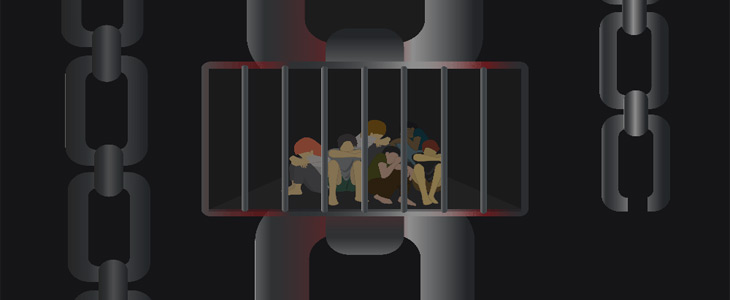
Modern slavery, which represents the recruitment, transport, receipt and harboring of people for the purpose of exploiting their labor, affects almost all parts of the world. Globally, it is estimated that there are over 40 million men, women and children in modern day slavery, with about half of that population in Asia alone.1 Alliance 8.7 reports the following statistics on human trafficking in Asia,
“Figures for the absolute numbers of persons in modern slavery underscored the importance of the Asia and Pacific region, where 62% of all victims of modern slavery worldwide were located. This was followed by the Africa region (23%), Europe and Central Asia (9%), the Americas (5%) and finally the Arab States (1%). The Asia and the Pacific region has the highest share of victims across all forms of modern slavery, accounting for 73% of victims of forced sexual exploitation, 68% of those forced to work by state authorities, 64% of those in forced labor exploitation, and 42% of all those in forced marriages.”2
These victims—found in factories, construction sites, within fisheries and sex venues—are forced to work for little or no pay, deprived of their freedom and often subjected to unimaginable suffering.
While most people think modern slavery focuses primarily on women and girls being forced into the sex industry, this represents only about 19% of the total forced labor cases. Beyond this, 64% of the victims are associated with supply chains and the private sector, which begin with a grower or producer and end as a finished product purchased by consumers in the retail market.3
For over more than a decade, the international modern slavery response community has not come close to meeting its full potential. While individual, small-scale success stories can be found, many victims are never identified. For example, the 2019 Trafficking in Persons Report was only able to account for 86,000 victims receiving assistance globally. During the same period, there were less than 7,000 convictions. This means that less than 1% of the victims are being identified and assisted each year. This number has remained unchanged for several years.4
Why are these numbers so low? According to the International Labor Organization, the profits generated from this illicit trade are estimated to exceed $150 billion annually. This means that every minute, this criminal industry makes more than $285,000 or $4,750 per second. Despite the size of the problem, annual global donor contributions add up to only around $350 million, which represents less than 1% of total profits generated by the criminals. With this in mind, it is not surprising that the number of trafficked persons continues to increase. According to the United Nations, modern slavery generates proceeds that represent the third most profitable multinational criminal activity after drug trafficking and counterfeiting of goods.5
Why should the banking/finance world care about this?
The main objective of modern slavery is exploiting a person to acquire money. The following are some of the main ways in which the financial services industry can be used as a conduit for this criminal activity.
First, proceeds of slavery may be laundered through legitimate financial systems. This can happen through money transfers to third parties; purchase of high-value goods; leasing of properties; or through commercial operations such as hotels and casinos. If these activities are discovered by regulators, it places banks at risk of significant fines and reputational damage. Understanding this risk, many banks are retooling to include modern slavery as one of the issues they track within their existing anti-money laundering (AML) protocols.
Second, traffickers often open personal and business accounts to handle the proceeds of their criminal activities. In transnational cases, traffickers frequently use financial systems to move modern slavery proceeds from one location to another, likely back to their country of origin.
Human trafficking is often a cash-based activity, so financial service providers dealing with cash are exposed to higher levels of risk. These include money services and remittance businesses, retail or branch banking, credit card companies, cash couriers, dealers in high-value goods and casinos.
In addition, banks may open accounts, underwrite loans or participate in investment involving businesses that are at high risk of becoming embroiled in modern slavery, such as manufacturing, packaging, mining, casinos, hotels and agriculture. These businesses are more exposed to this issue due to their complex supply chains, core business and recruitment of migrant workers.
When carrying out due diligence processes, financial institutions (FIs) must investigate the individuals and businesses to which they provide services. While this kind of screening is routine for detecting other forms of money laundering, modern slavery is a relatively new category. To detect this crime, banks need to apply appropriate risk profiling alongside red flag indicators, balanced against available resources and system constraints.
Emerging Responses
When addressing modern slavery, the financial services industry has a distinct advantage in being able to identify suspicious activity. With the right training and tools, this sector can be equipped to identify new money laundering trends that may be linked to slavery and in doing so, can also help offset the risk to their own organization from illegal and fraudulent businesses. Moreover, government laws such as the United Kingdom Modern Slavery Act are compelling boards of companies and FIs to consider their actions carefully and to address the issue of modern slavery. Below are nine strategies that the financial services sector is using to protect itself from the threat of money laundering linked to modern slavery:
- Using typologies to understand crime: This involves taking existing crimes and breaking them down into component parts in order to identify “red flags” that can be used as benchmarks or accurate predictors. This approach can help identify trends and patterns associated with money laundering within modern slavery.
- Using forensic accounting to identify crime: Forensic accounting combines traditional accounting procedures with investigative techniques to identify potential criminal behavior. Forensic accountants critically examine the complete financial operations of businesses and individuals, poring over financial documents and other data from which they root out irregular spending patterns or suspicious transactions.
- Working with nongovernmental organizations (NGOs) to collect data: The banking world is beginning to work more closely with NGOs to identify additional sources of information related to modern slavery. NGOs regularly come in contact with modern slavery cases, so banks can use this experience to identify typologies and red flags within their financial systems. NGOs can also be used to provide training in this area.
- Forging partnerships with law enforcement: One important way to understand the relationship between modern slavery and money laundering is to forge partnerships with law enforcement agencies and then work together to analyze data and identify typologies. This collaboration increases knowledge and awareness of threats, and can lead to the capture and prosecution of criminals.
- Identifying and using “red flag” indicators: The U.S. Department of Treasury’s Financial Crimes Enforcement Network maintains that certain red flags can signal possible modern slavery activity. These include transactions outside official hours of operation, cross-border transfer of funds inconsistent with the stated business purpose of the account holder, and a high number of individual accounts opened and closed simultaneously. Many banks are adopting these kinds of indicators in their compliance efforts.
- Creating and using big data filters: Once red flag indicators have been identified, banks can use big data filters that track suspicious transaction patterns. These filters are already being developed to combat modern slavery.
- Using criminal databases to screen clients: There are two databases—World-Check and WorldCompliance—that can be used to collect critical information to identify people or organizations involved in modern slavery. This allows the financial world to screen existing and prospective customers.
- Training of staff at all levels: Many banks are providing comprehensive training on modern slavery to ensure that all of their employees are aware of the issue and able to identify potential threats.
- Maintaining internal policies and procedures: Many banks are updating their internal policies and procedures to address the issue of modern slavery. In addition, clauses are being added to client agreements to provide detail about their policies on this issue.
How Bankers Can Be Heroic
In early December 2018, I traveled to Washington D.C. to attend the American Bankers Association’s Financial Crimes Enforcement Conference. As an anti-human trafficking expert, I was invited to participate in two panel discussions focusing on the issue of modern slavery and the banking sector. Following the second session, one of the bankers came up to me and told the following story.
Three years ago, this person and his family were traveling across several states in America by car to meet up with relatives. Following a long drive, he pulled into a small motel off the highway. Because it had been a long journey, his wife and two teenage daughters felt tired. That evening he went out to get some food for the family. As he was coming back to the motel, he noticed this very young teenage girl being pulled into a room by an older man. He said he remembered she had such a sad, frightened expression across her face. He knew immediately what was about to happen—she was a young prostitute about to be used by this patron. Since he had daughters of his own around the same age, he felt he needed to do something to help.
After dropping off the food, he went to the motel manager and told her what he saw. He then returned to his room not knowing if anything would happen. Twenty minutes later, there was a police car parked in front of the room. Ten minutes after that, he saw someone being taken out in handcuffs. The young girl was escorted to another car and driven away.
He said he remembered this event because he felt so good that he was able to help this young girl out of this terrible situation. In fact, he went on to say that this was a major milestone in his life—something for which he felt very proud.
After hearing his story, I asked him what he did for a living. He described that he was a compliance officer focusing on AML for one of the major American banks. I asked him if they did work related to the issue of modern slavery. He said they were just getting started in this area, which was why he came to the session. He went on to say that he felt his job was not very exciting and was not sure how much of a difference he was making.
After listening to his statement, I told the banker in front of me that while his day-to-day efforts might not seem as dramatic as his motel encounter, there were many people who could be assisted through his work in the coming years. In fact, I went on to say that those involved will be our future heroes because what they will do will not only help to protect their bank, but also help to protect many other people like that teenage girl.
Global banks need to understand that by addressing the issue of modern slavery, they are not only protecting their business, they are also helping to address one of the biggest injustices of our time. The outcome will be that many people will be freed from bondage, which makes their efforts truly heroic.
Matt Friedman, CEO, The Mekong Club, Hong Kong, matt.friedman@themekongclub.org
- “Global Estimates of Modern Slavery,” Alliance 8.7, 2017, https://www.ilo.org/wcmsp5/groups/public/---dgreports/---dcomm/documents/publication/wcms_575479.pdf
- Ibid, 27.
- Ibid, 10.
- “Trafficking in Persons Report,” U.S. Department of State, June 2019, https://www.state.gov/wp-content/uploads/2019/06/2019-Trafficking-in-Persons-Report.pdf, 38.
- “ILO says forced labour generates annual profits of US$ 150 billion,” International Labour Association, https://www.ilo.org/global/about-the-ilo/newsroom/news/WCMS_243201/lang--en/index.htm










